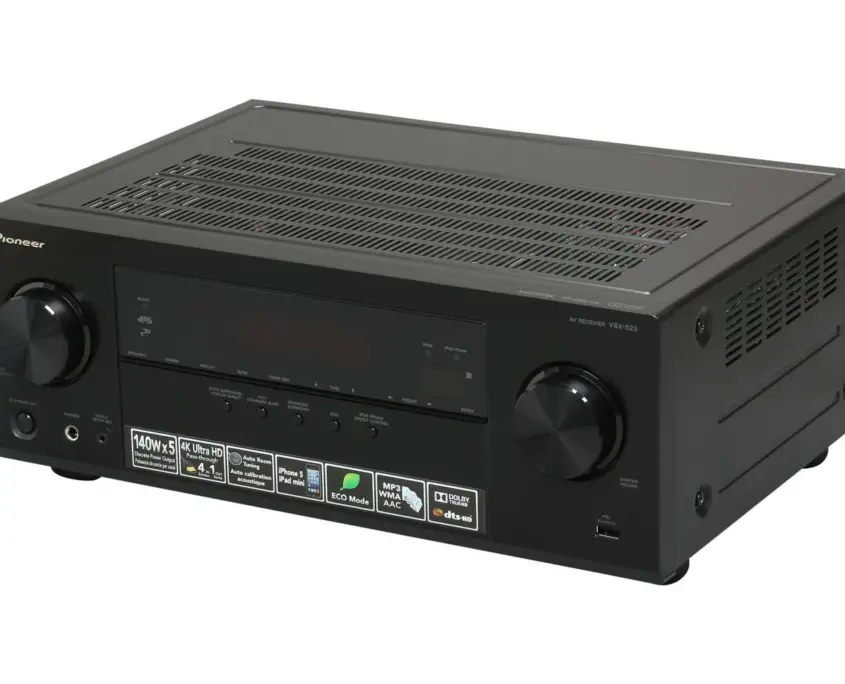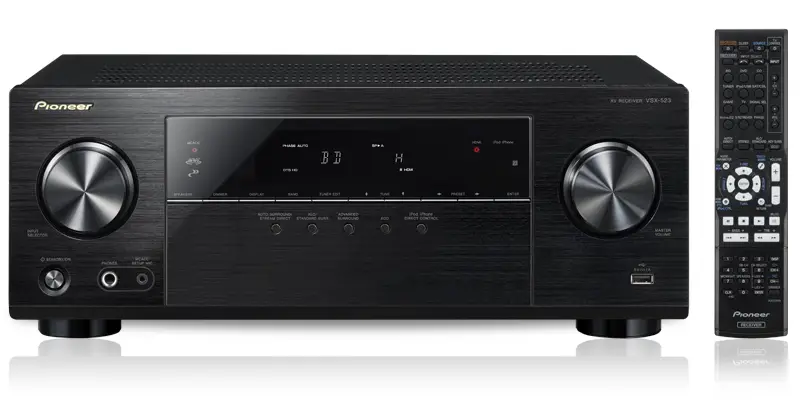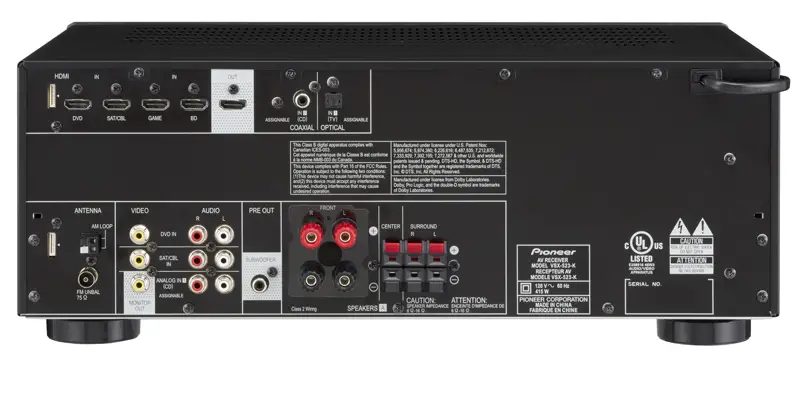
Another year, another refresh of home theater receivers from the biggest players in that industry. In order for companies to excel in this industry, they have to pump out models that are ready to interact with the latest technological trends. Many manufacturers now are competing vigorously in taking over the average consumer’s living room. Wireless technologies and improved video quality are often brought to the table but not everyone is willing to spend so much on making their living rooms so connected. Other people simply want better audio quality from their setups. Fortunately, people with those needs don’t have to spend so much and that is why the entry-level category of home theater receivers is just as competitive. Like some of its competitors, Pioneer decided to announce their new 2013 budget AV receivers back in March. The Pioneer VSX-523-K is one of the four AV receivers and it succeeds last year’s Pioneer VSX-522-K as the new entry-level model. Although it is priced at $279 rather than $249, the VSX-523-K has a couple of key improvements that are enough to disregard the older model regardless of its current price.
 Design
Design
Design isn’t exactly a huge deal when it comes to AV receivers so it is normal for newer models to have the same design as its predecessors. The Pioneer VSX-523-K is no exception and it even has the same remote control design. The brushed aluminum finish makes this home theater receiver resemble a more premium model which is nice but it weighs considerably lighter at around 18 pounds. Unlike some competing AV receivers, the VSX-523-K features a dedicated knob for the input selector in addition to the standard master volume knob on the opposite end. The button arrangement is fairly standard but it has a new button labeled “Eco“. This points to one of the new features which will be discussed in the next section of this review.
What is a bit disappointing with the Pioneer VSX-523-K is that it still has a minimal set of front panel connections. This might be a good thing for some people that may want a cleaner look but you will have no choice but to plug in your portable HDMI-equipped devices in one of the HDMI inputs on the back unless you have an iPod, iPod Touch, iPad or iPhone which can all connect to the USB port found on the front. The only other connections present on the front are the phones jack and setup mic for the MCACC feature.
The back of VSX-523-K looks very minimal as well and the arrangement of terminals should make it easy for newbies that have never used an AV receiver before to understand. There are 4 HDMI inputs on the back and are all properly labeled so you can easily switch to them. Of course, any component or device that supports HDMI including 3D-supported devices can work. The HDTV is naturally plugged in the HDMI output terminal. Older DVD players and cable boxes can still use the composite jacks.
Below is the back panel layout. Click on image to enlarge for a clearer view.

Pioneer VSX-523-K Back Panel
Features
With the same discrete direct energy design as the VSX-522-K, the power specifications are the same so you get 140 watts per channel. 5.1-channel speaker systems are supported and sound great as DTS-HD Master Audio and Dolby TrueHD decoders are onboard. Just about all home theater systems support them nowadays and they are important if you want to make the most out of the experiences Blu-ray movies provide. Dolby Pro Logic IIz is supported too if you need boost your audio quality by adding height channels.
In order to experience the best audio quality out of the home theater receiver’s capabilities, you have to calibrate your speakers. The exact adjustments that you make on each speaker vary depending on their positioning in the room making it a challenge to do manually. But Pioneer has been incorporating a feature that automatically calibrates their speakers to all their models. Pioneer calls this feature the Multi-Channel Acoustic Calibration system (MCACC). To calibrate your speakers, all you need to do is plug in the microphone included in the package to the MCACC jack and place the microphone on your ideal listening spot. When you run the calibration procedure, the Pioneer VSX-523-K will acknowledge various parameters including the size of your speakers when calibrating the speakers.
There are also some other features that are worth exploring before you figure out how to physically set up your speakers. If you find it difficult to create a classic 5.1-channel surround sound setup, you can place all of the speakers in the front and utilize the Front Stage Surround Advanced feature to virtually reproduce the standard setup. The Phase Control feature can also improve the sound image. If you have a massive MP3 collection, you might notice that the MP3s with smaller file sizes have poorer quality due to the low bitrates. The Advanced Sound Retriever feature can dramatically improve the quality of these tracks. Finally, the Auto Level Control can be used to equalize the volume levels of various sources.
All the features mentioned so far are present in the Pioneer VSX-522-K as well so what makes this model different? The biggest addition is the new ECO Mode which brings down the standby power consumption to just 0.1 watts. The USB port has also been updated to support the latest Apple products including the iPhone 5 and iPad Mini. These devices utilize the new Lightning port and you can now use your original Lightning cables to connect and charge these devices through USB. The last new addition is support for 4K Ultra HD content. This actually isn’t a big deal since this home theater receiver is targeting a budget audience but it is worth mentioning anyway since 4K displays could be affordable one of these days.
Bottom Line
If you already have a Pioneer VSX-522-K, you shouldn’t upgrade unless you have a new iPhone or iPad. But if you don’t have an AV receiver and don’t want to break the bank, the VSX-523-K is a compelling sub-$300 choice. Understand that by choosing the Pioneer VSX-523-K , you give up the networking features that other Pioneer receivers have but the audio enhancements are on the mark and don’t disappoint. The automatic calibration functionality is something worth considering too since some competing entry-level models don’t come with this feature.
